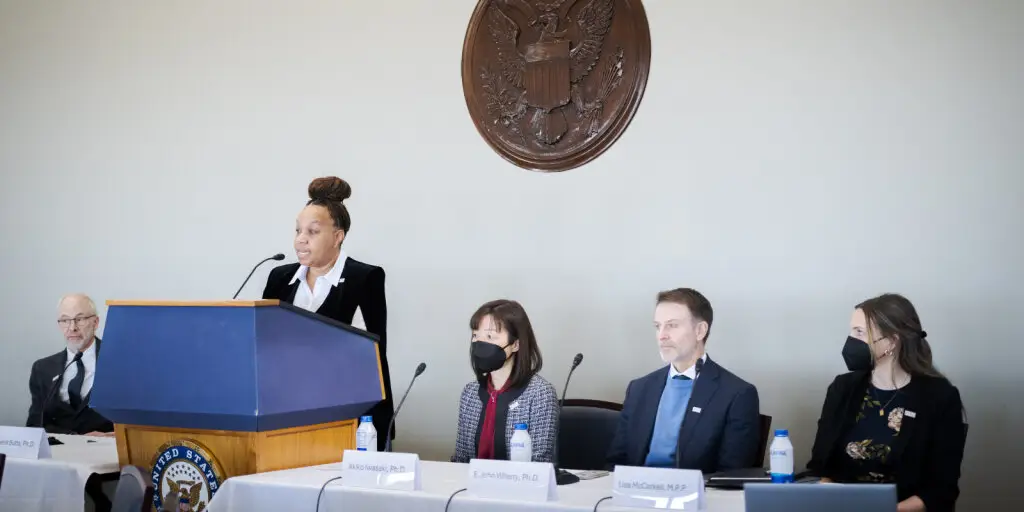
As the world moves forward from the COVID-19 pandemic, millions of people continue to battle its lingering effects. Long COVID, an often debilitating condition estimated to affect nearly 17 million Americans, remains a major public health crisis. Despite progress in understanding its causes, there are still no FDA-approved treatments, leaving many to struggle with life-altering symptoms. Addressing this crisis requires urgent action in research, policy, and clinical trials, according to AAI members Dr. Akiko Iwasaki and Dr. E. John Wherry, who recently spoke at AAI’s first ever congressional briefing on the future of Long COVID treatment and research.
Understanding the Root Causes of Long COVID
Dr. Akiko Iwasaki, Sterling Professor of Immunobiology at Yale School of Medicine, emphasized that Long COVID is a complex condition with multiple potential causes. Identifying these root causes is essential for developing targeted treatments. Dr. Iwasaki outlined four primary hypotheses driving Long COVID research: viral reservoirs, autoimmunity, tissue damage, and latent virus reactivation.
“We know that viral RNA can persist for hundreds of days in tissue like the gut in people who have had COVID,” Dr. Iwasaki explained. This lingering virus may contribute to ongoing illness, stimulating chronic immune responses and inflammation.
Viral infections can trigger autoimmune diseases, leading to the immune system mistakenly attacking the body’s own tissues. “This happens because virus infection triggers significant inflammation that elicits immune cells recognizing both the virus and the body itself,” she noted.
Even mild COVID-19 infections can cause long-term changes in the brain and other organs. “A respiratory infection alone can communicate to the brain through immune factors, triggering chronic changes in brain cells and potentially leading to cognitive impairment,” Dr. Iwasaki warned.
Dormant viruses, such as Epstein-Barr and varicella-zoster (chicken pox and shingles), may reactivate in Long COVID patients, possibly exacerbating symptoms. Research is ongoing to determine whether these reactivations are a cause or a side effect of the condition.
The Need for a Robust Clinical Trial and Treatment Infrastructure
While understanding Long COVID’s root causes is critical, Dr. E. John Wherry, Professor at the Institute for Immunology and Immune Health, University of Pennsylvania, highlighted the need for a strong clinical trial framework to translate this knowledge into effective treatments.
“This is a really important problem, not just because of the medical issues and suffering, but also due to the massive economic impact,” Dr. Wherry said. “Long COVID is affecting an estimated 17 million Americans with a cost ranging from one to three trillion dollars in economic losses.”
Despite the scale of the crisis, clinical trials remain insufficient. “If you look at clinicaltrials.gov, there are about 550 trials listed, but the vast majority are observational,” he explained. “Only a couple dozen interventional trials are using drugs with strong scientific rationale. We need to significantly expand and improve our approach.”
To create a more effective treatment landscape, Dr. Wherry outlined several key priorities. These include more mechanism-driven research to understand the biological processes driving Long COVID that will allow for targeted therapies. Additionally, large, structured patient groups to collect rigorous data on symptoms, disease progression, and treatment responses must be established. And there needs to be a stronger clinical trial infrastructure – a coordinated approach across academia, industry, and government to accelerate drug testing and approvals.
Dr. Wherry also commented on the need for accessible sample and metadata repositories. “We need to make sure we’re accessing the right biological markers at the right time,” Dr. Wherry stressed. “Waiting months to analyze immune system changes could hinder effective treatment strategies.”
NIH and FDA leadership are also vital. “We need to make sure the NIH and FDA are strong partners,” Dr. Wherry urged. “If we lose funding for these institutions, we lose the ability to conduct essential trials.”
The Path Forward
One promising initiative is the RECOVER-TLC program, designed to test multiple therapies in parallel and fostering collaboration among academia, industry, and federal agencies. “We can’t treat all patients with one drug because Long COVID is so varied,” Dr. Wherry emphasized. These trials will allow researchers to cycle in different treatments, identifying the most effective options for different patient groups.
Ultimately, sustained federal investment is crucial. “Funding for the NIH is the best return on investment we get for any government funding,” Dr. Wherry pointed out. “Practically all new drugs come from NIH-funded research.”
Long COVID is not a condition that will simply fade away. Drs. Iwasaki and Wherry made it clear that to tackle this crisis, we must invest in cutting-edge research, streamline clinical trials, and ensure that those suffering receive the care and treatment they need.




